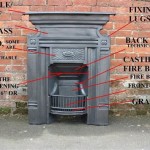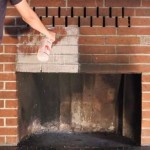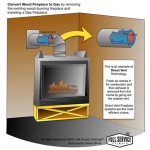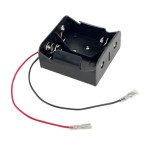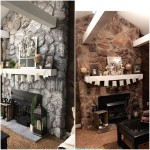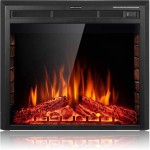Gas Fireplace Pellet Stove Inserts: A Comprehensive Overview
Gas fireplace pellet stove inserts represent a hybrid heating appliance designed to offer the convenience of a gas fireplace with the efficiency and environmental benefits associated with pellet stoves. These inserts are engineered to fit directly into existing masonry or prefabricated fireplace openings, providing a cost-effective and practical solution for upgrading outdated or inefficient fireplaces. Understanding the functionality, benefits, and considerations surrounding gas fireplace pellet stove inserts is crucial for homeowners seeking to enhance their home heating systems.
Traditional fireplaces, while aesthetically pleasing, often suffer from poor energy efficiency. A significant portion of the heat generated by a wood-burning fireplace escapes up the chimney, resulting in minimal warming of the room and increased fuel consumption. Pellet stoves, known for their high efficiency and controlled combustion, offer an alternative. However, some homeowners prefer the visual appeal and ease of use associated with gas fireplaces. Gas fireplace pellet stove inserts attempt to bridge this gap by combining the features of both types of heating appliances.
The core principle behind a gas fireplace pellet stove insert involves using natural gas or propane to ignite and burn wood pellets within a specially designed combustion chamber. The heat produced is then circulated into the room through convection fans or radiant heat, much like a traditional pellet stove. The gas component primarily initiates and sustains the combustion process, allowing for easier operation and automatic ignition. This allows for automatic ignition, flame height adjustment, and temperature control, offering convenience not generally found in traditional wood-burning stoves.
Understanding the Mechanics of Gas-Assisted Pellet Combustion
The operation of a gas fireplace pellet stove insert hinges on a carefully calibrated interplay between gas and pellet combustion. Inside the insert, a hopper stores wood pellets, which are automatically fed into the combustion chamber via an auger system. This auger is typically electronically controlled, allowing for precise regulation of the fuel supply.
When the insert is activated, a dedicated gas burner ignites within the combustion chamber. The flame from this burner heats the wood pellets, causing them to release combustible gases. These gases, combined with the heat from the gas burner, ignite the pellets and initiate a sustained combustion process. The gas burner continues to operate, supplementing the heat generated by the burning pellets and ensuring stable and efficient combustion, even during fluctuations in pellet quality or air supply.
The burning pellets release heat, which is then transferred to the surrounding air. This is often facilitated by a heat exchanger, a series of metal tubes or fins that maximize the surface area exposed to the hot combustion gases. A convection fan blows air across the heat exchanger, circulating the warmed air into the room. Some models also incorporate radiant heat panels, which emit heat directly into the room, providing a more immediate and localized warming effect.
Importantly, the gas component is designed to minimize gas consumption once the pellets are burning efficiently. The primary role of the gas is to initiate and maintain combustion, not to be the primary source of heat. This design ensures that the unit operates with the high efficiency characteristic of pellet stoves while offering the convenience of gas ignition and control.
Ash produced during combustion is collected in an ash pan located at the bottom of the unit. Regular emptying of the ash pan is necessary to maintain optimal performance and prevent potential hazards. A venting system, typically using a direct vent configuration, exhausts the combustion gases safely to the outside, ensuring proper indoor air quality.
Advantages of Gas Fireplace Pellet Stove Inserts
Gas fireplace pellet stove inserts provide several advantages over traditional fireplaces and conventional pellet stoves. These benefits stem from the hybrid nature of the appliance, combining the desirable features of both types of heating systems.
One key advantage is enhanced convenience. The gas-assisted ignition system simplifies operation significantly. Instead of manually lighting a wood fire, homeowners can simply turn on the insert, and the gas burner will automatically ignite the pellets. This eliminates the need for kindling, newspaper, and other fire-starting materials. Furthermore, many models offer thermostatic control, allowing users to set a desired room temperature and have the insert automatically adjust its heat output to maintain that temperature. This level of automation is not generally available with traditional wood-burning fireplaces.
Improved energy efficiency is another significant benefit. Compared to traditional fireplaces, gas fireplace pellet stove inserts offer significantly higher efficiency ratings. The controlled combustion process, coupled with the heat exchanger and convection fan, maximizes heat transfer and minimizes heat loss up the chimney. This translates to lower fuel consumption and reduced heating costs, particularly for homeowners who rely on the fireplace as a primary heating source.
Environmental considerations also favor gas fireplace pellet stove inserts. Wood pellets are a renewable fuel source, often made from recycled wood waste. Burning pellets produces significantly less particulate matter and other pollutants compared to burning wood in a traditional fireplace. The use of natural gas or propane for ignition further reduces emissions compared to using fire-starting chemicals or heavily taxed wood.
Installation is generally straightforward, particularly when replacing an existing fireplace. The insert is designed to fit within the existing firebox, minimizing the need for extensive structural modifications. However, professional installation is recommended to ensure proper venting and gas line connections. The aesthetic appeal is also a factor. These inserts come in a variety of styles and finishes, allowing homeowners to choose a model that complements their existing décor.
Considerations and Potential Drawbacks
Despite their numerous advantages, gas fireplace pellet stove inserts are not without potential drawbacks. Careful consideration of these factors is crucial before making a purchase decision.
One key consideration is the reliance on both gas and electricity. While the gas component primarily facilitates ignition and combustion, the insert also requires electricity to power the auger, convection fan, and control system. This means that the insert will not function during a power outage unless it is connected to a backup generator or battery system. Homeowners who experience frequent power outages may need to consider this limitation.
The cost of fuel is another factor to consider. While wood pellets are generally less expensive than oil or propane, the price of pellets can fluctuate depending on location, availability, and seasonal demand. Similarly, the cost of natural gas or propane can also vary. Homeowners should factor in the cost of both fuel sources when evaluating the long-term operating costs of the insert. The reliance on two fuel sources can require more intricate planning for fuel storage and purchasing strategies.
Maintenance is also an important consideration. Like all heating appliances, gas fireplace pellet stove inserts require regular maintenance to ensure optimal performance and longevity. This includes regular cleaning of the combustion chamber, ash pan, and venting system. The auger and other mechanical components may also require periodic maintenance or replacement. While the maintenance requirements are generally less demanding than those of a traditional wood-burning fireplace, they should not be overlooked.
Noise levels can also be a concern for some homeowners. The convection fan, while essential for circulating heat, can produce a noticeable humming sound. While the noise level is typically not excessive, it may be noticeable in quiet environments. Some models offer variable fan speed settings, allowing users to adjust the fan speed and noise level to their preference.
Finally, the initial cost of a gas fireplace pellet stove insert can be higher than that of a traditional fireplace or even a basic pellet stove. However, the increased efficiency and convenience can often offset the higher initial cost over the long term, especially for homeowners who use the fireplace frequently as a primary heating source. It is essential to compare the initial cost with the potential long-term savings and benefits when making a purchase decision.
In conclusion, gas fireplace pellet stove inserts offer a compelling combination of convenience, efficiency, and environmental benefits. However, careful consideration of the limitations and requirements is essential to ensure that the insert is the right choice for individual needs and circumstances. Evaluating fuel costs, maintenance requirements, and the reliance on both gas and electricity will help homeowners make an informed decision and enjoy the benefits of this versatile heating appliance.

Pellet Fireplace Inserts Lopi Stoves Made In Usa

Pellet Fireplace Inserts Lopi Stoves Made In Usa

Fireplace Insert Stoves Wood Gas Pellet Traditional Baltimore Maryland

Pellet Fireplace Inserts Complete Home Concepts

Pellet Stove Inserts The 1 Fireplace

Pellet Stove Inserts Turn Drafty Fireplaces Into Heaters Complete Home Concepts

Wood Stoves Pellet Gas Fireplace Inserts

Gci60 Cast Iron Pellet Stove Insert Regency

Fireplace Insert Installation Wood Inserts Gas Pellet And Electric

Pellet Fireplace Inserts Lopi Stoves Made In Usa

